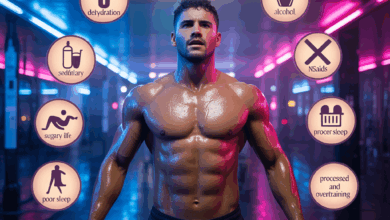Addicted to Pre Workout Signs and Cures: Spot It Early and Break the Cycle

Ever find yourself eyeing the neon tub of pre-workout like it’s a lifeline before every gym session — and feeling flat or anxious if you skip it? You’re not alone. Many gym-goers, from busy professionals to weekend warriors, lean on stimulant-packed supplements to power through workouts. But when “need” replaces “want,” it’s time to take a closer look. This guide will help you recognize the common signs you’re addicted to pre workout and give practical, sustainable cures so you can train smarter — not harder.
What is pre-workout and why people get hooked
Pre-workout supplements typically combine caffeine, amino acids (like beta-alanine), nitric oxide boosters, and other stimulants to increase energy, focus, and pump. They can be incredibly effective — and fast-acting. The problem: frequent use of high-caffeine, stimulant-heavy formulas can lead to tolerance, dependence, and withdrawal symptoms. Over time, the same scoop that once supercharged you might barely move the needle, prompting higher doses and more frequent use.
Addicted to pre workout signs and cures: how to spot and overcome dependency
Common signs and symptoms of pre-workout addiction
- Needing your pre-workout to feel “normal” before training — workouts feel impossible without it.
- Increasing doses or taking it more often to chase the original effect (tolerance).
- Withdrawal symptoms when you skip it: fatigue, headaches, irritability, poor concentration.
- Sleep disturbances, heart palpitations, anxiety, or elevated resting heart rate.
- Neglecting other healthy habits because supplements are viewed as a shortcut.
Real-world example
Sam, a 28-year-old software engineer, started using pre-workout twice a week. Within months it became a daily habit — sometimes twice a day to power through late-night study sessions. Sam noticed insomnia, jitteriness, and reduced performance unless he doubled the dose. After tapering over two weeks and swapping in non-stimulant strategies, Sam’s sleep improved and he regained his baseline energy without dependence.
Practical cures: how to quit or cut back without tanking your workouts
1. Taper instead of quit cold turkey
For many people, reducing intake gradually minimizes withdrawal. Lower the scoop size by 25% each 4–7 days, or mix your pre-workout with half the usual dose and caffeine-free powder to maintain ritual without full stimulant load.
2. Replace stimulants with sustainable energy boosters
- Swap high-caffeine products for lower-caffeine alternatives or natural caffeine (green tea).
- Try non-stimulant pre-workout formulas that focus on creatine, beta-alanine, and citrulline.
- Hydration + a small carbohydrate snack (banana or rice cake) 30–60 minutes before training can significantly boost performance.
3. Optimize recovery and sleep
Better sleep reduces reliance on stimulants. Aim for consistent sleep timing, limit late-night screen exposure, and keep caffeine consumption to earlier in the day. If insomnia persists, consult a healthcare professional.
4. Use smart workout design
Structured workouts can reduce the psychological need for a stimulant. Use a mix of the following variations depending on your goals:
- Strength-focused days: lower rep ranges (3–6) with longer rest — requires less constant high-energy output.
- High-Intensity Interval Training (HIIT): shorter, intense bursts with clear finish lines — short duration reduces reliance on long-lasting stimulants.
- Low-Intensity Steady State (LISS): active recovery days like brisk walking, cycling, or swim laps to maintain consistency without heavy stimulant needs.
- Technique and mobility sessions: replace some “energy-demanding” workouts with skill-focused sessions you can do without pre-workout.
5. Address nutrition and micronutrients
Consistent energy starts in the kitchen. Prioritize balanced meals with protein, carbs, and healthy fats. Iron, B12, and vitamin D deficiencies can cause fatigue — get checked and supplement only as needed. See our nutrition guides for sample pre- and post-workout meals.
When to seek help
If you experience severe palpitations, chest pain, panic attacks, or significant insomnia, stop stimulant use and consult a healthcare provider. For persistent dependence or if quitting leads to daily impairment (unable to work or function), professional support is advised.
Daily habits to prevent relapse
- Plan varied workouts using a schedule from our workout routines page to keep motivation high without stimulants.
- Practice stress management: breathing exercises, short walks, and mindfulness can reduce the mental reliance on “pre-workout hype.”
- Monitor caffeine from all sources (coffee, tea, soda) to avoid hidden intake.
- Keep a simple log: note how you feel and perform on stimulant-free days to remind yourself progress is possible.
Frequently Asked Questions
Q: Are pre-workouts actually addictive?
A: Pre-workouts containing caffeine and other stimulants can cause physical dependence and tolerance. While not addictive in the same way as some substances, they can create a strong psychological and physiological habit that’s hard to break.
Q: How long do pre-workout withdrawal symptoms last?
A: Mild withdrawal symptoms (headaches, fatigue, irritability) typically peak in the first 48–72 hours and can last up to one to two weeks. Tapering slowly helps reduce symptom severity.
Q: Will my performance drop if I stop taking pre-workout?
A: You may notice a temporary drop in perceived energy or focus, but true performance (strength, endurance) often recovers within a few weeks as tolerance resets and you adopt better sleep, nutrition, and training strategies.
Conclusion — take control of your training and energy
If you suspect you’re addicted to pre workout signs and cures are within reach: identify the symptoms, plan a taper, support your body with nutrition and sleep, and use stimulant-free training strategies. Try a 14-day stimulant-free challenge, track your energy and performance, and use our wellness tips to fill gaps in sleep and recovery. Want help building a stimulant-free plan tailored to your goals? Leave a comment or sign up for a personalized routine — your healthiest, most consistent gains are ahead.





